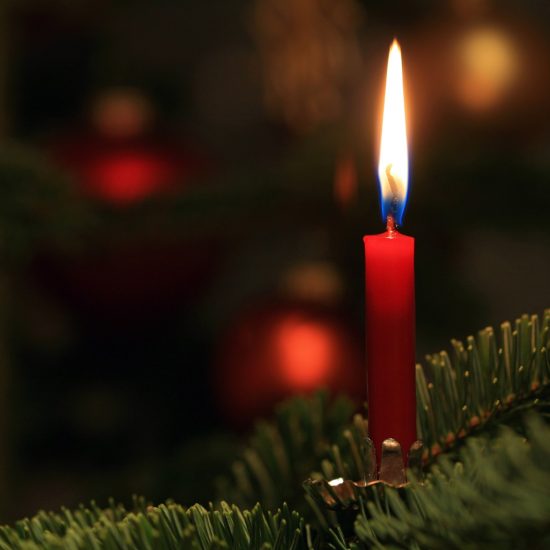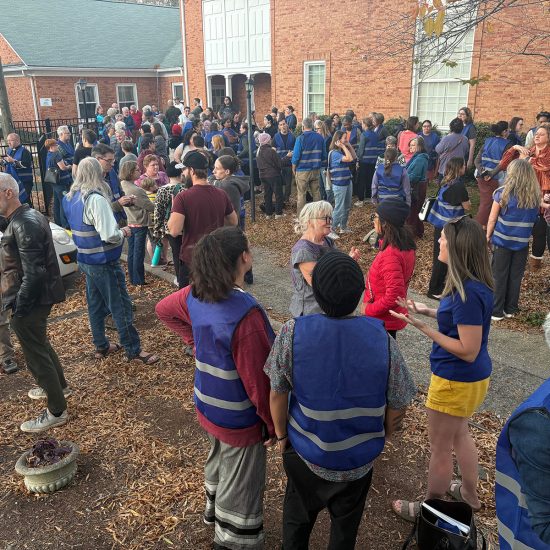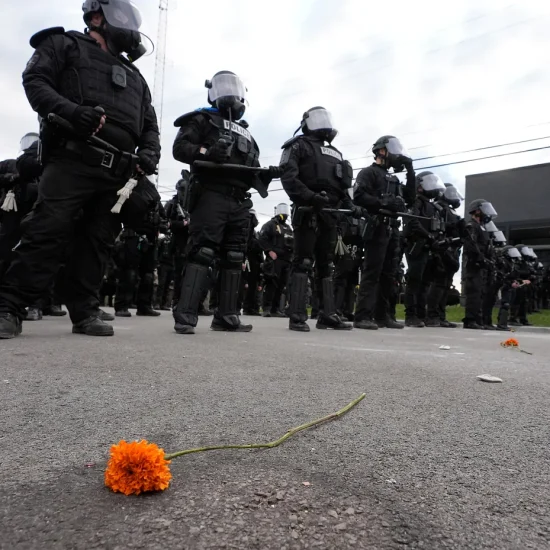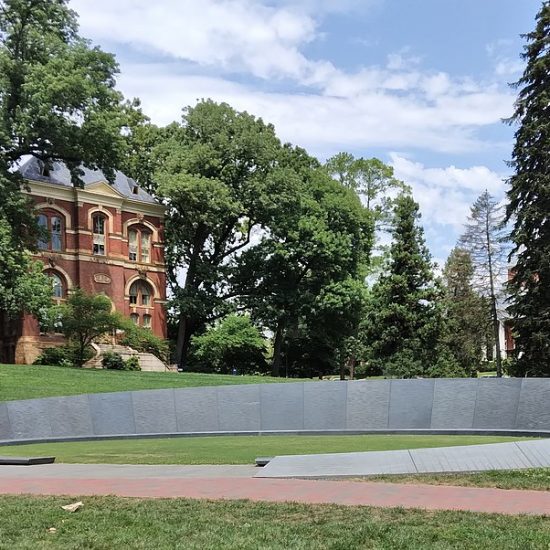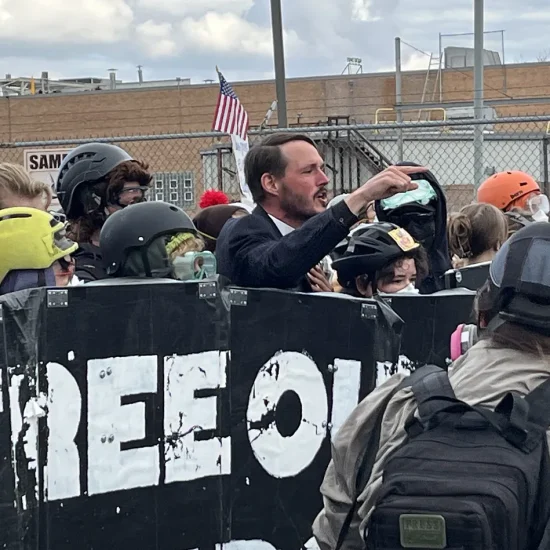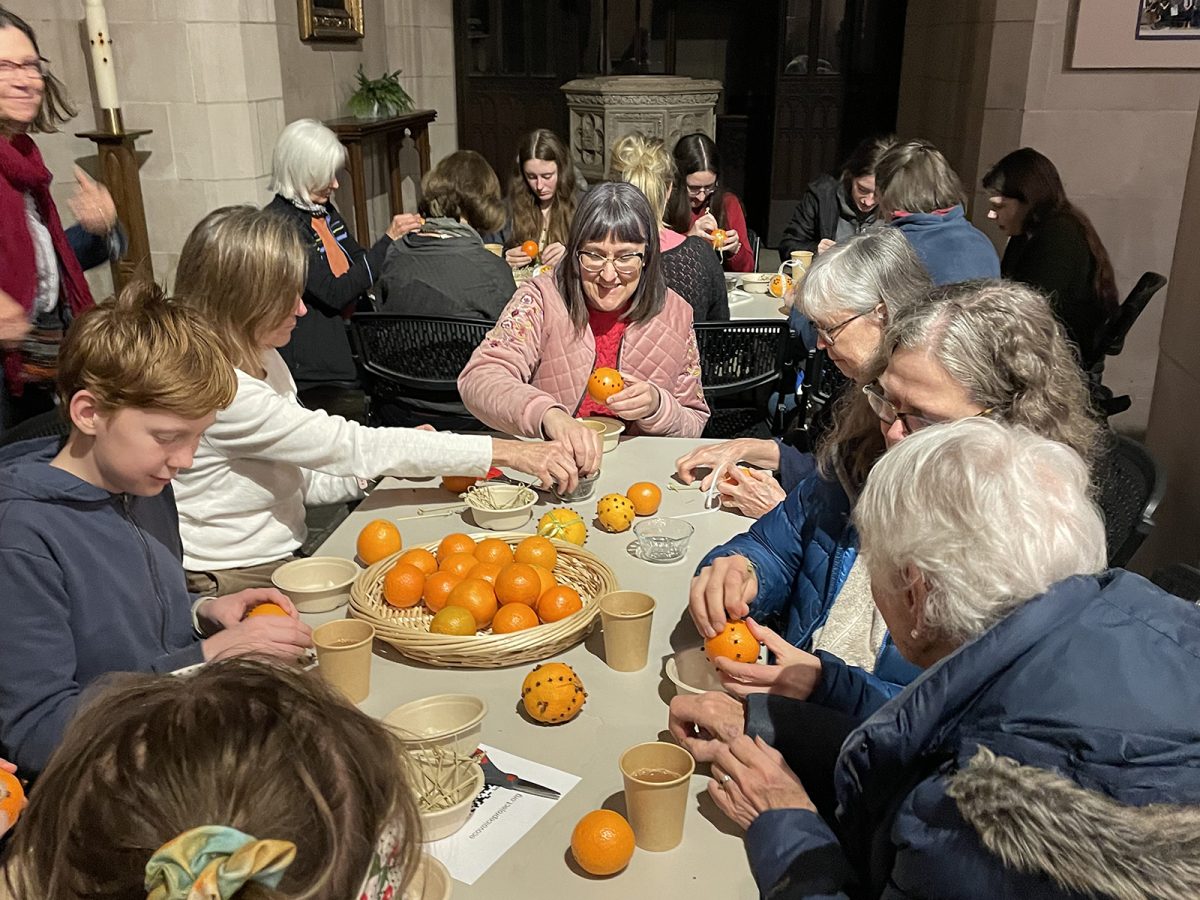
PITTSBURGH (RNS) — The Rev. Aidan Smith is no stranger to the dark, he told the members of Trinity Cathedral gathered beneath soaring gothic archways lit by candlelight in downtown Pittsburgh, Pennsylvania, on Wednesday evening (Dec. 18).
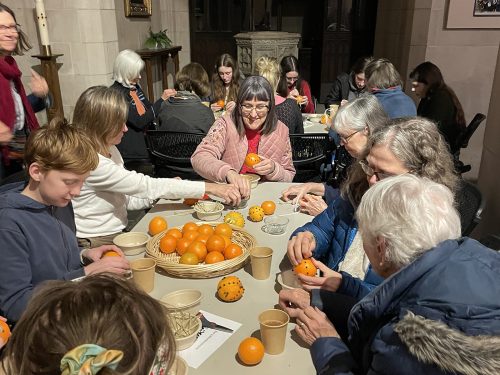
Attendees make pomander balls with oranges and cloves during a winter solstice celebration at St. Luke’s Episcopal Church in Evanston, Ill., on Dec. 21, 2023. (Courtesy photo)
Raised in northwest Alaska, he grew up experiencing significant periods of real darkness — sometimes, he said, the light would barely crest the horizon. In that context, darkness can feel oppressive, and on the winter solstice, darkness is at its peak.
“Sometimes, our lives can feel like the longest night of the year,” said Smith. But, he reminded the congregation, “darkness doesn’t have the last word.”
The 40-minute service featured hymns, a liturgy of the Word and holy Communion. One couple in attendance, Lucy Price and Lizzy Williams, said they appreciated the quieter, more reflective service that didn’t shy away from the more painful realities of life.
The cathedral is one of a growing number of mainline Christian churches across the U.S. to offer a service or celebration in conjunction with the winter solstice. While most are leaning into more somber Longest Night services, others are approaching the solstice as an opportunity for interfaith collaboration as solstice celebrations grow increasingly popular outside religious circles.

The Rev. Aidan Smith, center at altar, leads a Longest Night service at Trinity Cathedral in Pittsburgh, Penn., Wed., Dec. 18. 2024. (RNS photo/Kathryn Post)
At St. Luke’s Episcopal Church in Evanston, Illinois, a winter solstice celebration on Dec. 21 will feature wassail (a hot spiced beverage), earth-conscious crafts involving wax candles, oranges and cinnamon cloves, and a performance by the EcoVoice Project, a group that uses music to raise awareness of climate change.
The brainchild of EcoVoice director Kirsten Hedegaard, the interfaith community event is also curated by the church and by local groups Climate Action Evanston and Interfaith Action. Housed in a large stone gothic cathedral in a residential neighborhood, St. Luke’s, known in Evanston for its community activism, has previously collaborated with local churches to observe cross-quarter days, which fall midway between the solstices and equinoxes, via outdoor worship services involving prayer hikes, kite making and, in the fall, baking Communion bread from the first wheat harvest.

EcoVoice Project performs at St. Luke’s Episcopal Church in Evanston, Ill., on Dec. 21, 2023. (Courtesy photo)
“Adapting from having done the cross-quarter days into doing a solstice event was really, really natural for us,” said the Rev. Kathryn Banakis, rector at St. Luke’s.
Climate awareness is a key focus of the event, which will include tables populated by local environmental groups who will promote climate action items, including composting holiday trees, using sustainable gift wrapping techniques, and learning about proposed local ordinances that could impact greenhouse gas emissions. While the event will make space for grief, the framing of the event as celebratory is intentional.
“The enemy of climate action is climate anxiety, and the way to mitigate climate anxiety is group climate action,” said Martha Meyer, St. Luke’s representative to the Interfaith Action of Evanston’s Climate Change task force. “So it’s really important that we, when we are working on climate, that there’s a way to frame it as nature appreciation, love of seasons.”

The Rev. Burke Owens. (Courtesy photo)
Like the St. Luke’s event, the Winter Solstice program at First Palo Alto United Methodist Church on Friday evening is more spiritual than religious. The Rev. Burke Owens, who pastors the 130-year-old congregation in California’s Silicon Valley, hopes to introduce a bit of play at the inaugural service, which he said would feature an eclectic mix of songs (from Elizabethan carols to Joni Mitchell ballads), poems and a traditional Abbots Bromley horn dance that will acknowledge the cycles of nature and pay homage to animals.
“You have antlers, and you’re tapping them together and doing a simple dance around the chancel,” said Owens, describing the dance. “For some people, they might find it to be too far away from pure Christianity. I see that the relationship is there, because we’re celebrating the return of the sun, s-u-n, as well as the return of the son, s-o-n.”
St. Matthew’s Episcopal Church in Grand Junction, Colorado, is similarly hosting a winter solstice celebration that’s distinct from its Christmas or advent festivities. This will be the third year the event takes place, and the outdoor program will invite participants to walk the church’s labyrinth and place their written concerns in a fire that symbolizes God’s transformative power.
“We don’t try to connect this with the Christian holiday,” said the Rev. Janice Head, associate priest for healing and wholeness at the church. “It is a stand-alone event recognizing the cycle of nature, the movement from dark to light, from resting to waking.”
To medievalist Eleanor Parker, who wrote “Winters in the World: A Journey through the Anglo-Saxon Year,” the decision to hold separate winter solstice and Christmas events is interesting, given the historic overlap between the two. She noted that, when Roman Christians chose Dec. 25 as Christmas day (likely because it was nine months after the spring equinox, when some believed Jesus was conceived), it was the same day as the winter solstice. The date of the solstice has since shifted due to the inaccuracy of the Julian calendar. In the Middle Ages, Parker said, the winter solstice was seen simply as part of the yearly cycle, not a separate religious idea.
“They didn’t see any sort of conflict between the idea of, this is the solstice and we’re also celebrating Christmas … Really, they really are blended at that point,” said Parker. “That idea that lots of Christians think it’s a bit pagan to celebrate the solstice, that I think only comes back in the 19th century, the 20th century. It’s a really recent idea.” The 20th century’s New Age movements and revival of paganism, which views the solstices as the basis for the pagan year, according to Parker, contributed to the perception of Christmas and winter solstice as separate.
While some Christians today are wary even of Christmas traditions that seem a little too pagan, in theologically progressive Mainline Christian circles, winter solstice services — particularly of the more traditional “Longest Night” variety — have been around for awhile and are steadily growing in popularity. In the Episcopal diocese of Pittsburgh, the number of parishes offering this service has grown from one to 10 in the last decade or so.

Calvary Episcopal Church in Pittsburgh, Penn. (Photo by Ken Smith)
“There is a real need in our various communities for a pastoral response that takes into account the complicated feelings parishioners struggle with during the dark days of winter and also the holidays when depression and grief are often exacerbated,” said Bishop Ketlen A. Solak of the Episcopal Diocese of Pittsburgh.
When Bonnie-Marie Yager-Wiggan, now associate rector at Calvary Episcopal Church in Pittsburgh, first introduced the Longest Night service to Trinity Cathedral two years ago, it was in response to her own experience of losing a dear aunt to COVID-19 during the pandemic. She sees the pairing of advent and winter solstice as intuitive.
“We celebrate on the darkest night of the year because we remember that the light is coming, the sun will shine again,” said Yager-Wiggan. “And on a metaphysical, spiritual level, Christ is the light of world, and He will come again, which is the main theme of Advent: the second coming of Christ.”
Many clergy leading Longest Night or winter solstice events this year say the services are in response to both a desire to meet their congregants and community in the midst of the darkness of their own lives, and, perhaps, a broader, culture-wide desire to be more in tune with the natural world. To many clergy, this winter solstice — at the tail end of a fraught election year, in the midst of global wars, and in the wake of a pandemic — feels especially weighty.
“We’ve faced our mortality in new ways,” said the Rev. Brian Coulter, whose First Presbyterian Church in Fort Worth, Texas, is hosting its second Longest Night service in its chapel this Sunday. “There’s something in this idea of dark and light and hope and turning point that we feel as Christians, but it’s also just we feel as humans. … We’re not alone. The darkness is not going to win. We’re still here.”

An array of candles for the 2023 Longest Night service at First Presbyterian Church in Fort Worth, Texas. (Courtesy photo)

